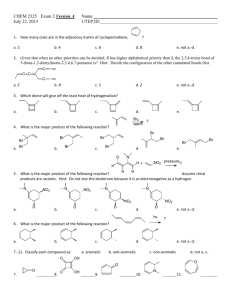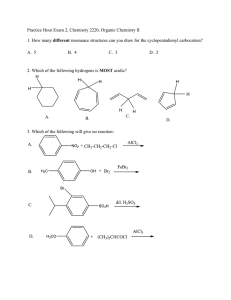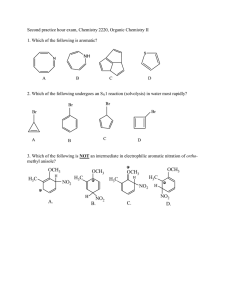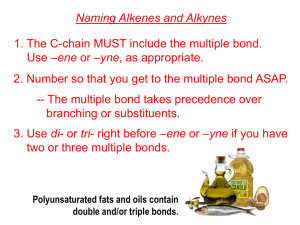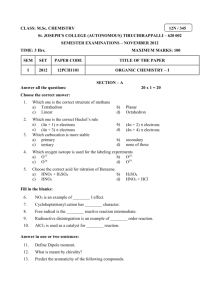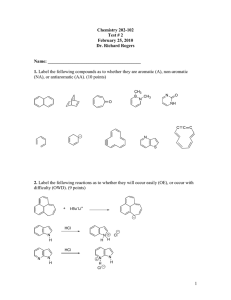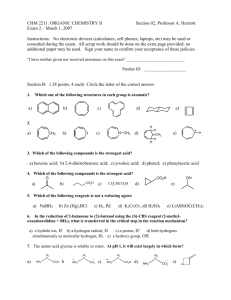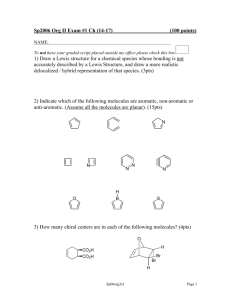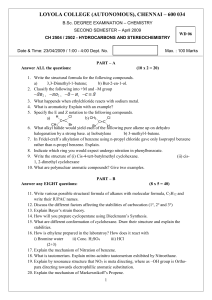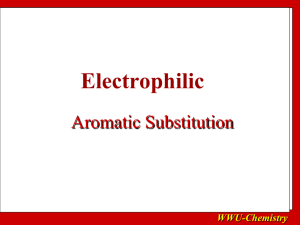Practice Hour Exam 2, Chemistry 2220, Organic Chemistry II different A.
advertisement
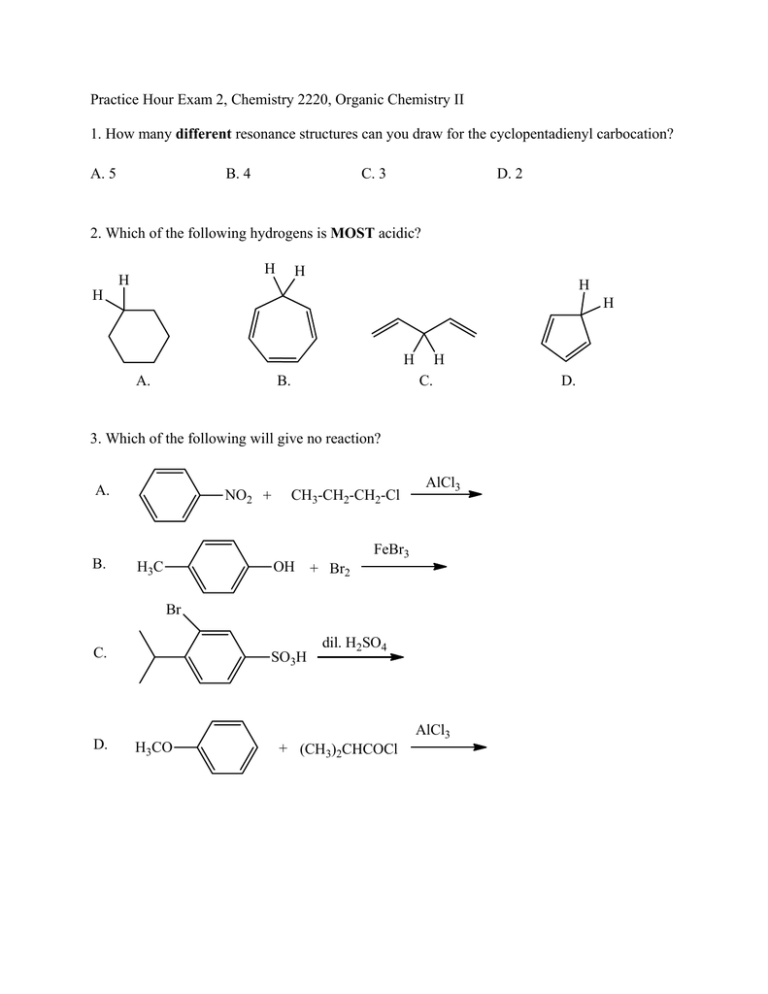
Practice Hour Exam 2, Chemistry 2220, Organic Chemistry II 1. How many different resonance structures can you draw for the cyclopentadienyl carbocation? A. 5 B. 4 C. 3 D. 2 2. Which of the following hydrogens is MOST acidic? H H H H H H H A. B. H C. 3. Which of the following will give no reaction? A. B. NO2 + CH3-CH2-CH2-Cl AlCl3 FeBr3 H3C OH + Br2 Br C. D. SO3H dil. H2SO4 AlCl3 H3CO + (CH3)2CHCOCl D. 4. Which of the following is the major product of the reaction below? 5. What is the product of this reaction? 6. Predict the product for the following reaction. 7. The mechanism of this reaction is: A. Nucleophilic addition, then elimination (SNAr) B. Elimination to a benzyne, then nucleophilic addition C. Electrophilic aromatic substitution D. Acid-base 8. Which is the correct pi orbital energy level diagram for the following compound? A. B. C. D. 9. Which of the following is the correct synthesis of the compound shown, from benzene? A. CH3CH2CH2Cl/AlCl3, then NBS/light, then KOH/heat B. Br2/FeBr3, then Mg/ether, then propanal, then H3O+ C. CH3CH2COCl/AlCl3, then Zn(Hg)/HCl, heat D. CH3CH2CH2Cl/AlCl3, then Br2/heat, then KOH/heat, then BH3-THF, then H2O2 with OH- 10. What is/are the major product(s) for the following reaction? A. B. Br Br D. C. 11. Which is the most stable resonance structure in the mechanism of nitration of toluene? CH3 CH3 CH3 A. CH3 NO2 B. NO2 C. NO2 D. NO2 12. What is the IUPAC name for the following compound? A. 2,5-dimethylpenten-3-one C. 2,5-dimethylcyclopenten-3-one B. 2,4-dimethyl-2-cyclopentenone D. 2,4-dimethyl-3-cyclopentenone 13. Compound X yields the following ozonolysis product. What is the structure of compound X? A. B. C. D. 14. What is the structure for 4-amino-2-bromophenol? 15. Which one of the following compound is nonaromatic (neither aromatic nor antiaromatic)? 16. Provide the reagents necessary to carry out the following conversion. A. HNO3 /H2SO4 B. NaBH4 C. HNO3 /H2SO4 NaBH4 HNO3 /H2SO4 1) Zn(Hg) 2) H3O+ D. 1) Zn(Hg) HNO3 /H2SO4 2) H3O+ 17. What is the product of the following series of reactions? 18. Predict the product of the following reaction: 19. How would you accomplish the following transformation? 20. Rank these compounds from fastest to slowest as they react in an EAS with Br2/FeBr3. A. III > V > II > I > IV C. IV > III > V > II > I 21. Predict the product of this reaction. B. I > IV > II > V > III D. I > IV > III > V > II 22. Which product will be produced in greatest yield? OH Cl2, AlCl3 Cl HNO3/H2SO4 OH OH NO2 Cl O2N OH D. Cl C. Cl B. NO2 A. OHO2N 23. Provide the structure of the ylide needed to prepare 3-ethyl-3-heptene from 3-pentanone using a Wittig reaction. A. Ph3P=C(CH2CH3)2 C. Ph3P=CHCH2CH2CH3 B. Ph3P=CHCH2CH3 D. Ph3P=C(CH3)2 24. Which of these statements is false, comparing benzene with 1,3,5-hexatriene? A. Benzene has the longest carbon-carbon bonds. B. Benzene releases less energy on hydrogenation. C. Benzene protons appear at ~7ppm in the 1H NMR spectrum. D. 1,3,5-hexatriene reacts easily with Br2 when cold/dark. 25. Which of these structures is not an intermediate in the acid-catalyzed reaction of acetone + methanol to produce the acetal? A. B. C. D.
